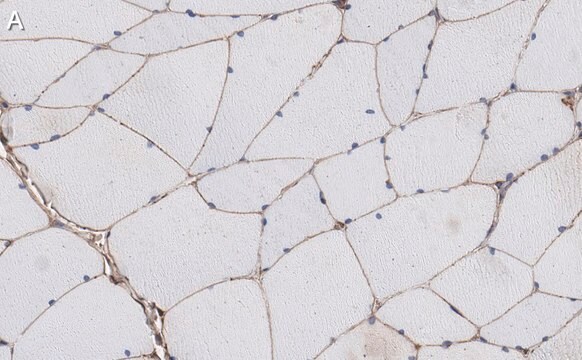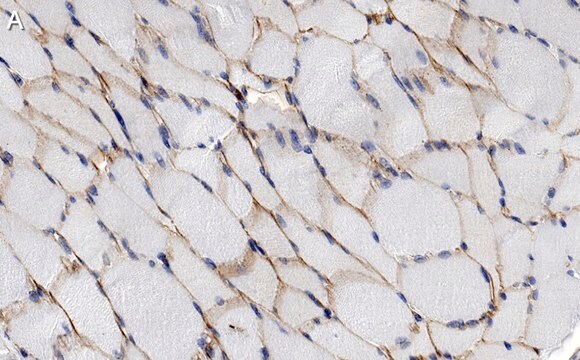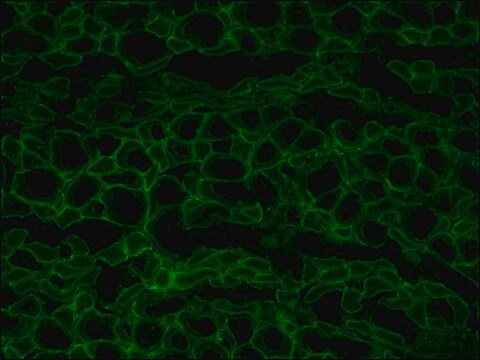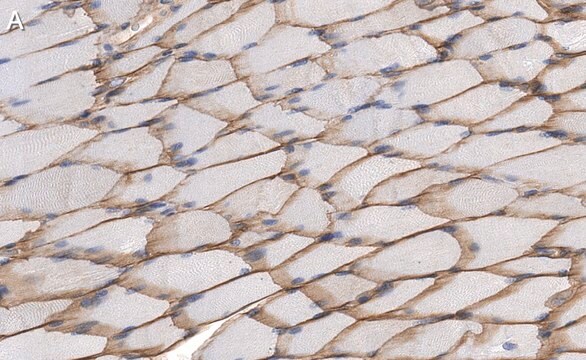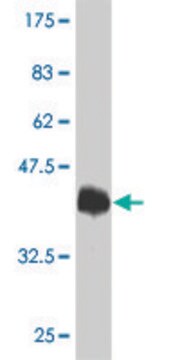About This Item
Polecane produkty
pochodzenie biologiczne
mouse
Poziom jakości
białko sprzężone
unconjugated
forma przeciwciała
purified antibody
rodzaj przeciwciała
primary antibodies
klon
IIH6 (or IIH6C4), monoclonal
masa cząsteczkowa
calculated mol wt 97.03 kDa
observed mol wt ~43 and 156 kDa
reaktywność gatunkowa
rabbit, human, mouse
reaktywność gatunkowa (przewidywana na podstawie homologii)
guinea pig, canine, rat
opakowanie
antibody small pack of 100 μL
izotyp
IgM
numer dostępu UniProt
Warunki transportu
dry ice
temp. przechowywania
-10 to -25°C
docelowa modyfikacja potranslacyjna
unmodified
informacje o genach
rabbit ... DAG1(100009278)
Opis ogólny
Specyficzność
Immunogen
Zastosowanie
Evaluated by Western Blotting in Rabbit skeletal muscle tissue lysate.
Western Blotting Analysis: 1:1,000 of this antibody detected Dystroglycan in Rabbit skeletal muscle tissue lysate.
Tested Applications
Western Blotting Analysis: A representative lot detected Dystroglycan in Western Blotting applications (Azzag, K., et. al. (2020). Skelet Muscle. 10(1):10 ; Bijata, M., et. al. (2015). Front Cell Neurosci. 9:199).
Immunohistochemistry (Paraffin) Analysis: A 1:50 dilution from a representative lot detected Dystroglycan in mouse heart and mouse skeletal muscle tissue sections.
Flow Cytometry Analysis: A representative lot detected Dystroglycan in Flow Cytometry applications (Gerin, I., et. al. (2016). Nat Commun. 7:11534).
Immunofluorescence Analysis: A representative lot detected Dystroglycan in Immunofluorescence applications (Azzag, K., et. al. (2020). Skelet Muscle. 10(1):10).
Inhibition Analysis: A representative lot reduced agrin-induced ERK activation in cardiac cells. (Bassat, E., et. al. (2017). Nature. 547(7662):179-184)
Immunohistochemistry Applications: A representative lot detected -Dystroglycan in Immunohistochemistry applications (Cataldi, M.P., et. al. (2018). Nat Commun. 9(1):3448).
Immunocytochemistry Analysis: A representative lot detected Dystroglycan in Immunocytochemistry applications (Bijata, M., et. al. (2015). Front Cell Neurosci. 9:199).
Note: Actual optimal working dilutions must be determined by end user as specimens, and experimental conditions may vary with the end user
Postać fizyczna
Przechowywanie i stabilność
Inne uwagi
Oświadczenie o zrzeczeniu się odpowiedzialności
Nie możesz znaleźć właściwego produktu?
Wypróbuj nasz Narzędzie selektora produktów.
polecane
Kod klasy składowania
10 - Combustible liquids
Klasa zagrożenia wodnego (WGK)
WGK 1
Temperatura zapłonu (°F)
Not applicable
Temperatura zapłonu (°C)
Not applicable
Certyfikaty analizy (CoA)
Poszukaj Certyfikaty analizy (CoA), wpisując numer partii/serii produktów. Numery serii i partii można znaleźć na etykiecie produktu po słowach „seria” lub „partia”.
Masz już ten produkt?
Dokumenty związane z niedawno zakupionymi produktami zostały zamieszczone w Bibliotece dokumentów.
Nasz zespół naukowców ma doświadczenie we wszystkich obszarach badań, w tym w naukach przyrodniczych, materiałoznawstwie, syntezie chemicznej, chromatografii, analityce i wielu innych dziedzinach.
Skontaktuj się z zespołem ds. pomocy technicznej